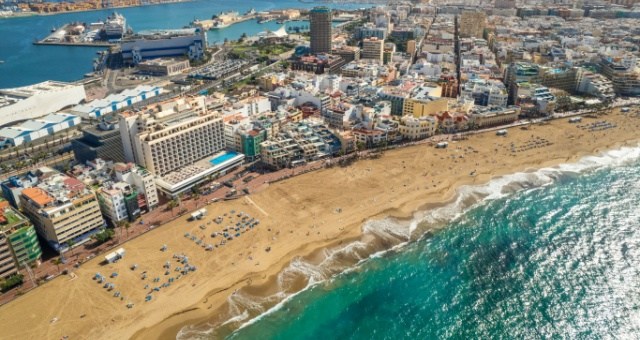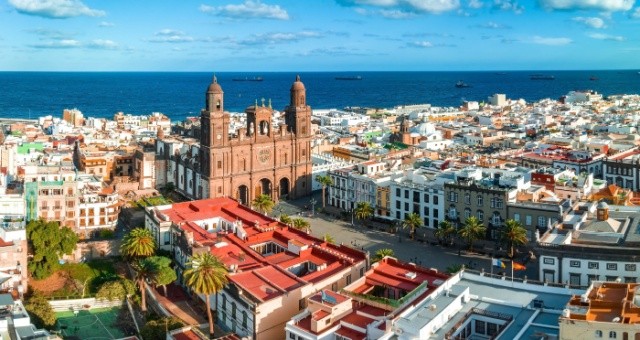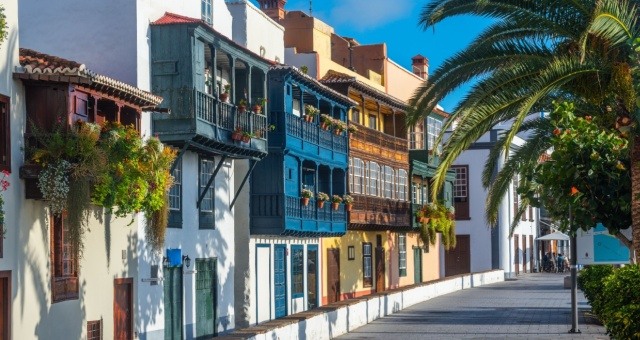Las Palmas or La Palma?
No, it's not the same placeIf you’re planning a break in Spain’s Canary Islands, you may be wondering “are Las Palmas and La Palma the same place?”. The names sound almost identical, but they point to different places. Las Palmas is the vibrant capital of Gran Canaria island, famous for its beaches and nightlife, while La Palma is a quiet, verdant island west of Tenerife.
Let’s unravel the confusion, discover what makes each destination special, and see how you can get there by ferry. With ferry tickets on Ferryhopper—at the best prices, of course.

Sunny day at Las Canteras beach in Las Palmas de Gran Canaria
Why the confusion?
The Canary Islands are split into 2 provinces: Santa Cruz de Tenerife and Las Palmas.
- Las Palmas refers to both the province that includes Gran Canaria, Fuerteventura and Lanzarote, and the capital city of Gran Canaria. There is no island called “Las Palmas.”
- La Palma, rightfully nicknamed La Isla Bonita, is an entirely separate island in the province of Santa Cruz de Tenerife.
It’s no wonder people get mixed up, especially when booking flights or ferries. Now that you know that Las Palmas is a city and La Palma is an island, you can book with confidence and avoid ending up in the wrong place.
Las Palmas de Gran Canaria: a cosmopolitan capital by the sea
Perched on the northeast coast of Gran Canaria, Las Palmas boasts sunshine and spring‑like temperatures most months of the year. Locals often joke there’s only about 6 degrees difference between winter and summer. It’s a city where surfers share the waterfront with history enthusiasts and shoppers, and where festivals and cultural events keep the calendar busy all year round.
Things to do in Las Palmas
- Wander along Playa de Las Canteras: this 3-km urban beach is sheltered by a natural volcanic reef which, at low tide, creates a calm lagoon perfect for swimming or snorkelling. Grab an ice cream and take an evening stroll along the promenade.
- Lose yourself in Vegueta: the city’s historic centre is a maze of cobbled streets lined with 15th‑century houses. Visit Santa Ana Cathedral to admire its neoclassical facade and Gothic interior, then step into Casa de Colón to see models of Christopher Columbus’s ships and old nautical maps.
- Shop along Calle Triana: the city’s elegant pedestrian avenue is lined with cafés and boutiques. Nearby, you will also find Mercado de Vegueta where you can taste Canarian cheeses, tropical fruit, and other island flavors.
- Follow the coastal path: the 7-km Sendero Azul links Bahía del Confital with Las Canteras. Along the way, you can see caves carved into the cliffs that once sheltered aboriginal communities and savour amazing views of the city skyline.
- Visit Poema del Mar Aquarium: Europe’s largest aquarium is part science museum, part underwater art gallery. Wander through tropical jungle, coral reef, and deep‑ocean tanks hosting mesmerising sea creatures.
- Join the carnival: Las Palmas throws one of the oldest and most flamboyant carnivals in the Canaries, featuring colourful parades, live music and lots of glitter.
Getting to Las Palmas by ferry
The main port of Las Palmas, Puerto de la Luz, makes reaching the city surprisingly easy. Here are the most popular routes:
- From mainland Spain: if you’re up for a longer voyage, overnight ferries depart from Cádiz and Huelva on the Andalusian coast. The journey takes around 30-32 hours but offers the adventure of arriving in the Canaries by sea. Find detailed info about Cádiz - Las Palmas and Huelva - Las Palmas ferry routes.
- From Tenerife: ferries to Las Palmas from Tenerife (Santa Cruz) depart several times a day, taking roughly 1 hour and 40 minutes. It’s the shortest route to Las Palmas from other islands in the Canaries and a favourite with commuters and day‑trippers.
- From Fuerteventura: services from Fuerteventura to Las Palmas de Gran Canaria bring passengers across in 2 to 7 hours, depending on the port of departure (Morro Jable or Puerto del Rosario). You get to sail past Fuerteventura’s dunes and arrive in the heart of the city.

The beautiful city and majestic Cathedral of Santa Ana in Las Palmas
La Palma: the wild “Isla Bonita”
Far to the west, La Palma is often called La Isla Bonita (The Pretty Island); and it truly lives up to the name. It’s a UNESCO Biosphere and Starlight Reserve thanks to its natural wonders, including lush forests, dramatic ravines, and crystal‑clear night skies.
The most picturesque Canary island covers about 708 square kilometres, and its highest point, Roque de los Muchachos, reaches 2,426 metres.
Things to do in La Palma
- Explore Caldera de Taburiente National Park: at the island’s centre lies a huge volcanic crater that’s now a green amphitheatre. Hike among waterfalls and pine forests, discover lava tubes, and climb up to Roque de los Muchachos for panoramic views of the archipelago.
- Wander through laurel forests: the north of the island is home to the ancient woodlands of Los Tilos and Las Nieves. The trails there, such as Marcos y Cordero and Cubo de la Galga, lead to gorges, springs, and waterfalls. No wonder locals also call La Palma La Isla Verde, the green island.
- Gaze at the stars: strict light‑pollution laws protect the night sky over La Palma, which is exceptionally dark. Climb up to the Mirador del Llano del Jable viewpoint or book a guided visit to the observatory at Roque de los Muchachos to witness constellations like never before.
- Swim at volcanic beaches: you might not find golden sands on the island, but the black‑sand coves have their own exceptional beauty. Enjoy a dip at Puerto de Tazacorte, hike down to Playa de Nogales for a more secluded swim, or visit Playa de Echentive, created by a 1971 eruption.
- Explore colourful towns: the island’s capital, Santa Cruz de La Palma, is a showcase of colonial architecture, narrow cobbled streets, and wooden balconies. On the west coast, Los Llanos de Aridane buzzes with cafés and street art, while in villages like San Andrés and El Tablado offer a glimpse of traditional island life.
Getting to La Palma by ferry
La Palma has one port, Santa Cruz de La Palma, located on the east coast. This is how to get there by sea:
- From mainland Spain (Cádiz): once a week, a long‑distance ferry departs from Cádiz to La Palma. The crossing takes over 2 days, and is a great option for travellers who want to bring along their car to the Canaries or enjoy a mini‑cruise.
- From Tenerife (Los Cristianos): high‑speed catamarans connect Los Cristianos on Tenerife’s south coast with La Palma in about 2.5 hours. The Tenerife (Los Cristianos) - La Palma connection is the fastest way to reach the island and runs around 3 times a day. Once a week, there’s also a departure from Santa Cruz de Tenerife.
- From Las Palmas (Gran Canaria): ferries sail from Las Palmas to Santa Cruz de La Palma a few times a week. The journey usually includes a stop on Tenerife and takes around ten hours, so many travellers opt to break it up by exploring another island on the way.
Find out all about how to get to La Palma on our dedicated guide.

The picturesque streets and traditional architecture of Santa Cruz de la Palma
So, where will you go?
City lover or nature adventurer?
If you dream of strolling from museums to cafés and relaxing on an urban beach, Las Palmas is the place to be for you. The city’s lively atmosphere and frequent ferries to nearby islands make it a great base for island hopping around the Canaries.
If, on the other hand, you are craving for towering pines, volcanic paths, and nights spent counting shooting stars, head to La Palma. The island’s pristine landscapes, serene villages, and clear skies are impossible not to fall in love with.
Picked your destination? Use our Map of ferries to visualize your trip, compare prices, and book your ferry tickets with ease. Then all that’s left is to start your adventure – buen viaje!